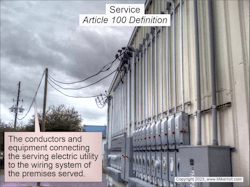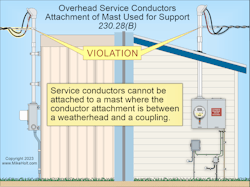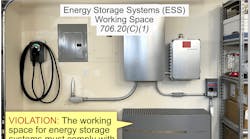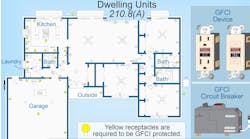Article 230 covers the installation requirements for service conductors and service equipment.
A service consists of the conductors and equipment connecting the serving electric utility to the premises wiring system [Art. 100] (Fig 1).
Number of services
There are many possible combinations of what is considered one service drop or one service lateral. A building can be served by only one service except as permitted by Sec. 230.2(A) through (D).
(A) Special Conditions. Additional services are permitted for the six reasons listed in Sec. 230.2(A). These include fire pumps and emergency systems.
(B) Special Occupancies. Additional services are permitted for either multiple-occupancy buildings where there’s insufficient space for supply equipment accessible to all occupants, or a building so large that one service doesn’t cut it.
(C) Capacity Requirements. Additional services are permitted for buildings with capacity requirements exceeding 2,000A, or if the load requirements of a single-phase installation exceed the serving electric utility’s power capacity.
(D) Different Characteristics. Additional services are permitted for different voltages, frequencies, or phases but also different uses such as varying electricity rate schedules.
If a building has more than one service, a permanent plaque or directory must be installed at each service disconnect location indicating the location of other services supplying that building [Sec. 230.2(E)].
This is vital to first responders who must disconnect power to the building.
Service conductors through buildings
Service conductors must not pass through the interior of a building to supply another building [Sec. 230.3].
Conductors are considered outside a building or structure when installed [Sec. 230.6]:
(1) Under at least 2 in. of concrete beneath a building.
(2) Within a building or structure in a raceway encased at least 2 in. of concrete or brick.
(3) In transformer vaults.
(4) In dirt floor buildings, with the raceway installed at least 18 in. below the finished surface.
You can’t install feeder and branch-circuit conductors in the same raceway, cable, handhole enclosure, or underground box with service conductors [Sec. 230.7]. Doing this would bypass the feeder or branch-circuit overcurrent protection if there’s a short between those conductors and service conductors (Fig. 2).
Service, feeder, and branch-circuit conductors are permitted in the service disconnect enclosure.
Where a service raceway enters a building or structure from outside, it must be sealed per Sec. 300.5(G) and Sec. 300.7(A) [Sec. 230.8]. Sealants must be identified for use with cable insulation, conductor insulation, bare conductor, shield, or other components.
Overhead service conductors
Overhead service conductors are the overhead conductors between the serving electric utility service point and the first point of connection to the service-entrance conductors at the building [Art. 100].
“Service Point” is where the serving electric utility conductors connect to customer-owned premises wiring.
“Service Drop” is the set of utility-owned overhead conductors between the serving electric utility transformer and the service point [Art. 100].
Overhead service conductors must have sufficient ampacity to carry the load as calculated per Parts II through V of Art. 220 [Sec. 230.23(A)].
Overhead service conductors cannot be smaller than 8 AWG copper or 6 AWG aluminum [Sec. 230.23(B)]. Exception: Overhead service conductors can be as small as 12 AWG for limited-load installations.
The neutral conductor for overhead service conductors must be sized to carry the maximum unbalanced load per Sec. 220.61 and no smaller than required by Sec. 250.24(D)(1) [Sec. 230.23(C)].
The service neutral conductor must not be smaller than required by Sec. 250.24(D)(1) to ensure it has sufficiently low impedance and current-carrying capacity to safely carry fault current to facilitate the operation of the overcurrent protective device [Sec. 250.4(A)(5)].
Overhead service conductors must maintain a clearance of 3 ft from windows that open, doors, porches, balconies, ladders, stairs, fire escapes, or similar locations [Sec. 230.9(A)].
Overhead service conductors within 3 ft measured horizontally of platforms, projections, or surfaces that will permit personal contact must have a vertical clearance of at least 10 ft above the platforms, projections, or surfaces per Sec. 230.24(B) [Sec. 230.9(B)].
Overhead service conductors cannot be installed under an opening through which materials might pass and where they will obstruct entrance to building openings [Sec. 230.9(C)].
You can’t use trees or other vegetation to support overhead service conductor spans or service disconnects [Sec. 230.10].
Conductor spans above roofs must maintain a vertical clearance at least 8 ft - 6 in. above the surface of a roof for a minimum distance of 3 ft in all directions from the roof edge [Sec. 230.24(A)]. However, five exceptions exist. Here are two of those five exceptions.
- Exception No. 2: If the slope of the roof exceeds 4 in. of vertical rise for every 12 in. of horizontal run, the 120V/208V or 120V/240V overhead service conductor clearances can be reduced to 3 ft over the roof.
- Exception No. 5: If the voltage between conductors does not exceed 300V and the roof area is guarded or isolated, the clearance can be reduced to 3 ft.
Conductor spans above grade must maintain the following vertical clearances [Sec. 230.24(B)]:
(1) 10 ft above finished grade, sidewalks, platforms, or projections that permit personal contact for circuits supplied by 120V/208V or 120V/240V.
(2) 12 ft above residential property and driveways, and commercial areas not subject to truck traffic for circuits supplied by 120V/208V, 120V/240V, or 277V/480V.
(3) 15 ft above residential property and driveways, and commercial areas not subject to truck traffic for circuits supplied by a system having a voltage exceeding 300V to ground.
(4) 18 ft above public streets, alleys, roads, parking areas subject to truck traffic, driveways on other than residential property, and other areas traversed by vehicles such as those used for cultivation, grazing, forestry, and orchards.
(5) 24 ft - 6 in. above tracks of railroads.
Overhead service conductors above pools, outdoor hot tubs, fountains, and similar installations must comply with the clearance requirements in Sec. 680.9 [Sec. 230.24(D)].
The point of attachment for overhead service conductors must be at least 10 ft above the finished grade [Sec. 230.26]. It must be located so the minimum overhead service conductor clearances required by Sec. 230.9 and Sec. 230.24 can be maintained. The point of attachment for conductors might need to be raised so the overhead service conductors will comply with the clearances from building openings required by Sec. 230.9 and from other areas as required by Sec. 230.24.
Open conductors must be attached to fittings identified for use with service conductors or to noncombustible, nonabsorbent insulators securely attached to the building [Sec. 230.27].
Masts used for the support of overhead service conductors or service drops must be installed per Sec. 230.28(A) and (B):
(A) Strength. If a mast supports the service drop or overhead service conductors, it must have adequate mechanical strength, braces, or guy wires to withstand the strain caused by the conductors.
(B) Attachment. Conductors cannot be attached to a mast between a weatherhead or end of the conduit and a coupling if the coupling is above the last conduit support — or if the coupling is above the building (Fig. 3).
In addition, many electric utilities contain specific requirements for the installation of the service mast.
Underground service conductors
Underground service conductors are the underground conductors between the service point and the first point of connection to the service-entrance conductors in a terminal box, meter, or other enclosure, whether inside or outside the building wall [Art. 100].
“Service Point” is the point where the serving electric utility conductors connect to customer-owned premises wiring [Art. 100].
“Service Lateral” is the utility-owned underground conductors between the serving electric utility transformer and the service point [Art. 100].
Only the 11 wiring methods listed in Sec. 230.30(B) can contain underground service conductors. These include IMC conduit, PVC conduit, and IGS cable.
Underground service conductors must have the ampacity to carry the load as calculated per Parts II through V of Art. 220 [Sec. 230.31(A)]. Underground service conductors can’t be smaller than 8 AWG copper, 6 AWG aluminum, or copper-clad aluminum [Sec. 230.31(B)]. Exception: Underground service conductors can be as small as 12 AWG for limited-load installations.
The neutral conductor for underground service conductors must be sized to carry the maximum unbalanced load per Sec. 220.61 and not smaller than required by Sec. 250.24(D) [Sec. 230.31(C)].
Preventing potential problems
The service is where conductors have the most energy, undergo the most strain, and pose the greatest danger. When selecting or installing service conductors, it’s a good practice to assess what potential problems may exist and how you can avoid them. For example, something allowed by the Code, such as a second service, might not be the best engineering choice for optimizing performance and reliability.







